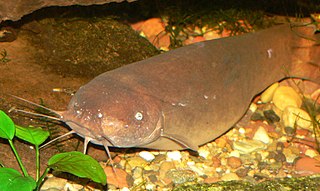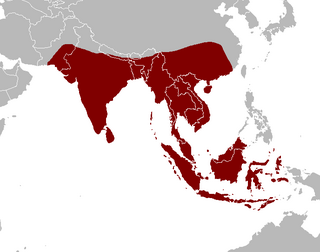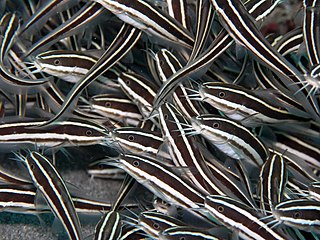
Catfish are a diverse group of ray-finned fish. Named for their prominent barbels, which resemble a cat's whiskers, catfish range in size and behavior from the three largest species alive, the Mekong giant catfish from Southeast Asia, the wels catfish of Eurasia, and the piraíba of South America, to detritivores, and even to a tiny parasitic species commonly called the candiru, Vandellia cirrhosa. Neither the armour-plated types nor the naked types have scales. Despite their name, not all catfish have prominent barbels or "whiskers". Members of the Siluriformes order are defined by features of the skull and swimbladder. Catfish are of considerable commercial importance; many of the larger species are farmed or fished for food. Many of the smaller species, particularly the genus Corydoras, are important in the aquarium hobby. Many catfish are nocturnal, but others are crepuscular or diurnal.

Cnidoglanis macrocephalus is a species of catfish of the family Plotosidae, and is the only species of the genus Cnidoglanis. It is commonly known as the cobbler, estuary cobbler, deteira, estuary catfish, South Australian catfish, or Swan River catfish.

Electric catfish or Malapteruridae is a family of catfishes. This family includes two genera, Malapterurus and Paradoxoglanis, with 21 species. Several species of this family have the ability to generate electricity, delivering a shock of up to 350 volts from its electric organ. Electric catfish are found in tropical Africa and the Nile River. Electric catfish are usually nocturnal and carnivorous. Some species feed primarily on other fish, incapacitating their prey with electric discharges, but others are generalist bottom foragers, feeding on things like invertebrates, fish eggs, and detritus. The largest can grow to about 1.2 meters long, but most species are far smaller.

The eel-tailed catfish, Tandanus tandanus, is a species of catfish of the family Plotosidae. This fish is also known as dewfish, freshwater catfish, jewfish, and tandan.

The Doradidae are a family of catfishes also known as thorny catfishes, raphael catfishes or talking catfishes. These fish are native to South America, primarily the Amazon basin and the Guianas.

The shark catfishes form the family Pangasiidae. They are found in fresh and brackish waters across southern Asia, from Pakistan to Borneo. Among the 30-odd members of this family is the plant-eating, endangered Mekong giant catfish Pangasianodon gigas, one of the largest known freshwater fish. Several species are the basis of productive aquaculture industries in Vietnam's Mekong Delta.

The Bagridae are a family of catfish that are native to Africa (Bagrus) and Asia from Japan to Borneo. It includes about 245 species. These fish are commonly known as naked catfishes or bagrid catfishes.

The loach catfishes are a family, Amphiliidae, of catfishes. They are widespread in tropical Africa, but are most common in streams at high elevations; most species are able to cling to rocks in fast-flowing streams. The 13 genera contain 68 species.

Phreatobius is a genus of very small catfishes from tropical South America.
Aguarunichthys is a genus of long-whiskered catfishes native to South America.
Cheirocerus is a genus of long-whiskered catfishes native to South America.

Paraplotosus is a genus of catfishes native to Australasia and South-east Asia.

Plotosus is a genus of eeltail catfishes native to the Indian Ocean, the western Pacific Ocean and New Guinea.

Amphilius is a genus of catfishes of the family Amphiliidae.

The bayad, is a species of bagrid catfish from Africa.
The Somalia catfish is a species of catfish in the family Bagridae. The Somalia catfish is native to the Jubba River in Somalia.

Galeichthys is a genus of sea catfishes in the family Ariidae, the only genus in the subfamily Galeichthyinae. It includes four predominantly marine species distributed in Southern Africa and northwestern South America:
Osmoregulation is the active regulation of the osmotic pressure of an organism's body fluids, detected by osmoreceptors, to maintain the homeostasis of the organism's water content; that is, it maintains the fluid balance and the concentration of electrolytes to keep the body fluids from becoming too diluted or concentrated. Osmotic pressure is a measure of the tendency of water to move into one solution from another by osmosis. The higher the osmotic pressure of a solution, the more water tends to move into it. Pressure must be exerted on the hypertonic side of a selectively permeable membrane to prevent diffusion of water by osmosis from the side containing pure water.

Plotosus lineatus, common name striped eel catfish, is a species of eeltail catfishes belonging to the family Plotosidae.

Neoarius graeffei, or blue salmon catfish, is a species of catfish found in freshwater rivers of Australia and Papua New Guinea. This species is most identifiable by its large, shark-like dorsal fin that is led by a poisonous spine. Like other catfish, the blue salmon catfish is known to use electrical pulses to sense prey in the water. This prey sensing mechanism may be the reason that these catfish are known to eat the land dwelling hopping mouse at a high rate.

















